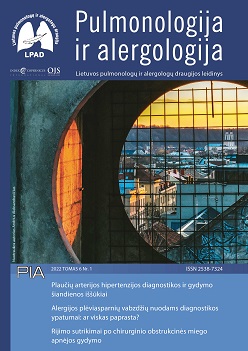DYSPHAGIA DISORDER AFTER SURGERY IN PATIENTS WITH OBSTRUCTIVE SLEEP APNEA
Abstract
The aim of the study. To evaluate the severity of dysphagia symptoms after surgery for obstructive sleep apnea (OSA) and to compare them with a control group of healthy subjects. The suitability of the Palate Post Operative Problems Score (PPOPS) questionnaire for use in clinical practice was also assessed. Methods. A total of 50 healthy controls and 157 patients aged from 16 to 65 (mean 40.38 ± 11.16) years old who underwent pharyngeal surgery at the Department of Otorhinolaryngology of Lithuanian University of Health Science between 2018 November 1st and 2019 October 30th were examined for dysphagia symptoms. The severity of dysphagia was assessed using the Visual Analogue Scales (VAS), Dysphagia Screening Questionnaire (DAQ) and PPOPS. Results. In both the study group and control group, the mean VAS scores for dysphagia symptoms were less than 3 points, thus indicating mild symptom severity. As compared to the controls, a higher VAS scores for „gagging/ coughing when swallowing“ and „foreign body sensation in the throat“ and higher PPOPS scores were found in the study group patients. When comparing subgroups of patients who underwent Radiofrequency surgery (RF), Palatoplasty surgery (PP) or TE surgery, higher VAS scores for „foreign body sensation in the throat“ after PP and TE and higher VAS scores for „gagging/ coughing when swallowing“ after TE were detected. Same, increased PPOPS scores were detected for RF, PP and TE patients compared to controls. Conclusions. Late dysphagia symptoms after surgery for OSA are mild, regardless of the type of pharyngeal surgery. Nevertheless, the VAS scores for “foreign body sensation in the throat“ and „gagging/ coughing when swallowing“ were generally higher in operated patients when compared to the controls. More pronounced dysphagia complaints were detected after PP and TE surgery compared with patients undergoing RF surgery. PPOPS questionnaire showed to be a useful and sensitive tool to detect postoperative dysphagia and is a suitable tool for usage in daily clinical practice.


